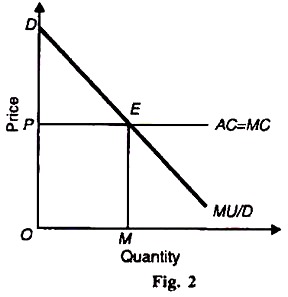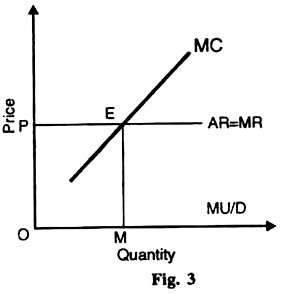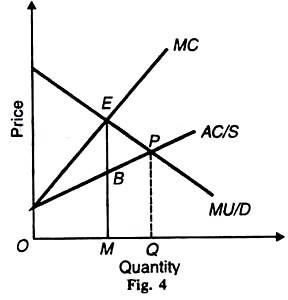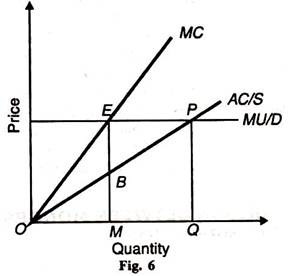This article will help you to learn about the difference between Monopsony and Perfect Competition.
Difference between Monopsony and Perfect Competition
Given the same straight line marginal utility (demand) curve and the average cost (supply) curve, a comparison between prices and amounts of a commodity bought under monopsony and perfectly competitive buying can be made as under.
(a) If the supply price is constant, the average and marginal cost curves coincide as in Figure 2 the amount OM of the product bought at the price ME (= OP), under monopsony is the same as under perfect competition because the MC curve will cut the horizontal AR=MR curve from below under perfect competition at point E, as shown in Figure 3.
(b) Under increasing supply price when the average and marginal cost curves are rising, the monopolist will pay fewer prices than the competitive buyer and he will buy a little more than half the competitive amount. This is illustrated in Figure 4 AC/S is the supply curve of the industry under perfect competition and MU/D is its demand curve.
The equilibrium between the two is established at P where OQ amount is bought at QP price. The monopolist equilibrium is at point E and his price MB is less than the competitive price QP and the amount OM is somewhat more than half the perfectly competitive output OQ.
(c) Figure 5 illustrates the case of a decreasing supply price where the average and marginal cost curves slope downward. Here the monopolist buys more than under perfect competition at a lower price. The monopolist equilibrium is at E. MB is the monopsony price which is less than the perfectly competitive price PQ, but the monopolistic amount OM is higher than the perfectly competitive amount OQ. 



